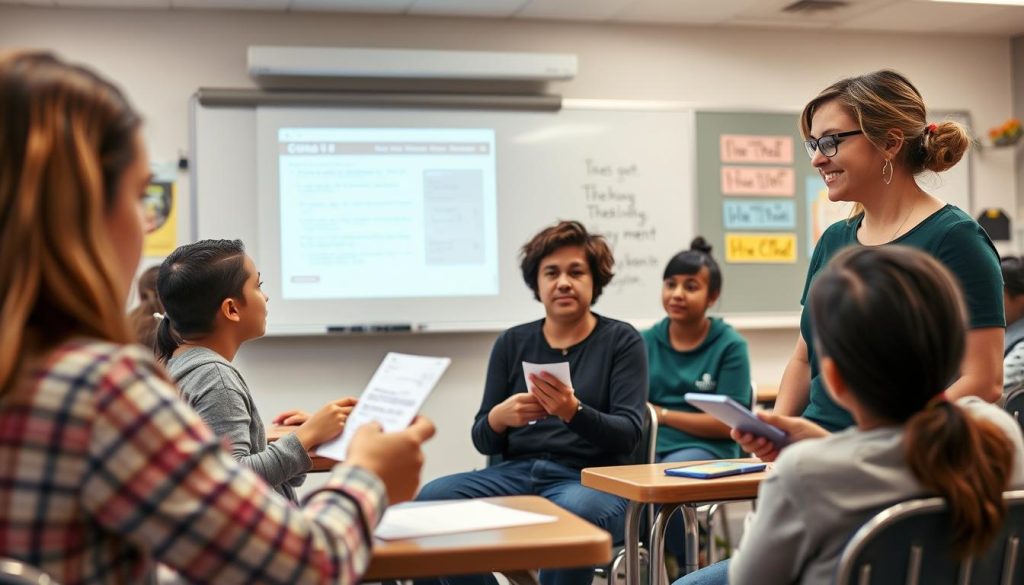What is Formative Assessment?
Formative assessment allows teachers to gather real-time data on student understanding
Formative assessment is an ongoing evaluation process that occurs during instruction rather than at the end of a unit or course. It provides teachers with immediate feedback about student comprehension, allowing for timely adjustments to teaching methods. Unlike summative assessments (like final exams or standardized tests), formative assessment is low-stakes and focused on the learning journey rather than final outcomes.
As education expert Paul Black famously put it, “When the cook tastes the soup, that’s formative assessment. When the customer tastes the soup, that’s summative assessment.” This analogy perfectly captures the essence of formative assessment – it’s about checking progress while there’s still time to make improvements.
Formative assessment encompasses a wide variety of methods, from quick exit tickets and classroom polls to peer feedback sessions and self-reflection activities. The key is that these assessments inform both teaching and learning in real-time, creating a dynamic feedback loop that benefits both teachers and students.
The Benefits of Formative Assessment for K12 Teachers
Implementing formative assessment in your classroom offers numerous advantages that can transform your teaching practice and improve student outcomes. Let’s explore the key benefits:
Real-Time Feedback and Instructional Adjustments
One of the most significant advantages of formative assessment is the ability to gather immediate feedback on student understanding. This real-time data allows you to make on-the-spot adjustments to your teaching, addressing misconceptions before they become deeply ingrained. These quick instructional pivots are essential teacher skills that can dramatically improve learning outcomes.

Personalized Learning Opportunities
Formative assessment helps you identify which students need additional support and which are ready for more challenging material. This information enables you to differentiate instruction effectively, providing targeted interventions for struggling students while offering enrichment opportunities for those who have mastered the content. Developing these differentiation teacher skills is crucial in today’s diverse classrooms.
Increased Student Engagement
When students receive regular feedback on their progress, they become more invested in their learning. Formative assessment techniques like think-pair-share, classroom polls, and exit tickets actively involve students in the assessment process, making learning more interactive and engaging. Research shows that this increased engagement leads to better retention and deeper understanding of content.
Development of Student Self-Assessment Skills
Regular formative assessment helps students develop metacognitive skills – the ability to think about their own thinking and learning. When students participate in self-assessment activities, they learn to identify their own strengths and weaknesses, set learning goals, and monitor their progress. These are valuable life skills that extend far beyond the classroom.
Reduced Test Anxiety
Because formative assessments are typically low-stakes or no-stakes, they help reduce the anxiety that many students experience with traditional testing. This creates a more positive classroom environment where mistakes are viewed as learning opportunities rather than failures. Creating this supportive atmosphere is among the essential teacher skills for fostering student growth.
Improved Summative Assessment Results
Regular formative assessment throughout a unit of study typically leads to better performance on summative assessments. By identifying and addressing learning gaps early, you help ensure that students have a solid foundation before moving on to more complex concepts. This proactive approach is much more effective than discovering knowledge gaps after a unit has concluded.
Enhance Your Formative Assessment Teacher Skills
Looking to master formative assessment strategies? Our professional development courses provide practical techniques you can implement immediately in your classroom. Earn credits while developing essential teacher skills.
Challenges of Implementing Formative Assessment
While formative assessment offers numerous benefits, it’s important to acknowledge the challenges that teachers may face when implementing these practices. Understanding these potential obstacles can help you develop strategies to overcome them.
Pros of Formative Assessment
- Provides real-time feedback on student understanding
- Allows for immediate instructional adjustments
- Enables personalized learning approaches
- Increases student engagement and participation
- Develops students’ self-assessment abilities
- Reduces test anxiety with low-stakes evaluation
- Improves performance on summative assessments
Cons of Formative Assessment
- Can be time-consuming to implement effectively
- Requires significant planning and preparation
- May generate large amounts of data to manage
- Can be challenging to implement in large classes
- Requires development of specific teacher skills
- May face resistance from students used to traditional methods
Time Constraints
One of the most significant challenges teachers face is finding time to implement formative assessment regularly. Between curriculum requirements, standardized testing preparation, and administrative duties, adding another layer of assessment can feel overwhelming. Developing efficient assessment teacher skills is crucial for managing these time constraints effectively.

Data Management Challenges
Formative assessment generates a significant amount of data, which can be challenging to organize, analyze, and use effectively. Without proper systems in place, valuable information may go unused or get lost in the shuffle. Learning effective data management teacher skills is essential for making the most of formative assessment.
Implementation Complexity
Some formative assessment strategies require specific materials, technology, or classroom setups that may not be readily available in all schools. Additionally, implementing new assessment methods often requires professional development and practice to execute effectively. These factors can make adoption challenging, particularly for teachers in resource-limited environments.
Student Resistance
Students accustomed to traditional assessment methods may initially resist formative assessment approaches, particularly those requiring active participation or self-reflection. Overcoming this resistance requires strong communication teacher skills to help students understand the value of these assessment methods.
Effective Formative Assessment Strategies for K12 Classrooms
Now that we’ve explored the benefits and challenges of formative assessment, let’s look at some practical strategies you can implement in your classroom. These approaches range from quick, low-prep activities to more structured assessment methods.
Quick Check Strategies
- Exit Tickets: Short written responses collected at the end of class to gauge understanding of the day’s lesson
- Thumbs Up/Down: A simple visual check for quick comprehension assessment
- One-Minute Papers: Brief written reflections on the main point of a lesson or lingering questions
- Digital Polls: Using technology to quickly gather student responses to check understanding
Deeper Assessment Strategies
- Think-Pair-Share: Students think individually, discuss with a partner, then share with the class
- Peer Feedback: Students review each other’s work using specific criteria
- Self-Assessment Checklists: Students evaluate their own understanding against learning objectives
- Concept Maps: Visual representations of knowledge showing relationships between concepts

Think-pair-share activities provide valuable formative assessment data while promoting collaboration
Technology-Enhanced Formative Assessment
Digital tools can streamline the formative assessment process, making it more efficient and engaging. Tools like Kahoot, Google Forms, Padlet, and Plickers allow you to quickly gather and analyze student responses. Developing technology integration teacher skills can significantly enhance your formative assessment practice.
Feedback-Focused Strategies
The quality of feedback provided during formative assessment is crucial. Effective feedback is specific, timely, and actionable, focusing on the task rather than the student. It should identify what the student did well, where improvement is needed, and specific steps for making that improvement. Mastering these feedback teacher skills is essential for maximizing the impact of formative assessment.
Developing Essential Teacher Skills for Formative Assessment
Implementing formative assessment effectively requires specific teacher skills that may need to be developed through practice and professional development. Let’s explore the key skills needed to maximize the impact of formative assessment in your classroom.
Professional development helps teachers build essential formative assessment skills
Questioning Techniques
Effective questioning is at the heart of formative assessment. Developing strong questioning teacher skills involves crafting questions that probe deeper understanding, encourage critical thinking, and reveal student misconceptions. Moving beyond simple recall questions to those that require analysis, evaluation, and creation is essential for gathering meaningful assessment data.
Data Analysis and Response
Collecting assessment data is only valuable if you can analyze it effectively and respond appropriately. These analytical teacher skills include identifying patterns in student responses, recognizing common misconceptions, and determining appropriate instructional adjustments based on the data collected.
Differentiation Based on Assessment Results
Once you’ve gathered and analyzed formative assessment data, the next critical teacher skill is using that information to differentiate instruction. This might involve creating flexible groupings, developing tiered assignments, or providing targeted interventions for students who need additional support.
Feedback Delivery
How you deliver feedback can significantly impact its effectiveness. Developing strong feedback teacher skills means learning to provide comments that are specific, constructive, and focused on improvement rather than judgment. Effective feedback should guide students toward next steps while maintaining their motivation and confidence.
Master Formative Assessment Techniques
Ready to take your teacher skills to the next level? Our specialized courses on formative assessment provide practical strategies you can implement immediately. Earn professional development credits while enhancing your classroom practice.
Balancing Formative Assessment in Your Teaching Practice
Finding the right balance for formative assessment in your classroom is crucial for maximizing its benefits while managing the challenges. Here are some strategies to help you integrate formative assessment effectively into your teaching practice.
Start Small and Build Gradually
Rather than trying to implement multiple formative assessment strategies at once, start with one or two simple techniques and use them consistently. As these become part of your routine, gradually add additional strategies. This approach allows both you and your students to adjust to new assessment methods without feeling overwhelmed.

Integrate Assessment into Existing Activities
Look for ways to build formative assessment into activities you’re already doing rather than creating entirely new tasks. For example, you might add a quick reflection question to homework assignments or incorporate peer feedback into group projects. This integration helps develop efficient assessment teacher skills without adding significant preparation time.
Use Technology Strategically
Digital tools can streamline the formative assessment process, making data collection and analysis more efficient. However, it’s important to select tools thoughtfully based on your specific needs and classroom context. Focus on technology that enhances rather than complicates your assessment practice.
Create Sustainable Systems
Develop systems for managing assessment data that are sustainable over time. This might include digital spreadsheets, portfolio systems, or simple notebook tracking methods. The key is finding an approach that provides useful information without creating an unmanageable workload.
Collaborate with Colleagues
Working with other teachers to develop and implement formative assessment strategies can lighten the workload and provide valuable insights. Consider forming a professional learning community focused on formative assessment to share resources, strategies, and experiences.
Conclusion: Making Formative Assessment Work for You
Formative assessment offers powerful benefits for both teachers and students when implemented effectively. By providing real-time feedback on student understanding, it allows you to make timely instructional adjustments and create more personalized learning experiences. While there are challenges to implementation, the strategies outlined in this article can help you overcome these obstacles and integrate formative assessment successfully into your teaching practice.
Remember that developing strong formative assessment teacher skills is a journey, not a destination. Start with small, manageable changes, reflect on their effectiveness, and adjust your approach as needed. With practice and persistence, formative assessment can become a natural and valuable part of your teaching repertoire, enhancing both your professional practice and your students’ learning outcomes.
Continue Your Professional Growth
Ready to enhance your formative assessment teacher skills? Our professional development courses offer practical strategies, expert guidance, and continuing education credits. Join thousands of K12 teachers who have transformed their assessment practices through our specialized programs.




